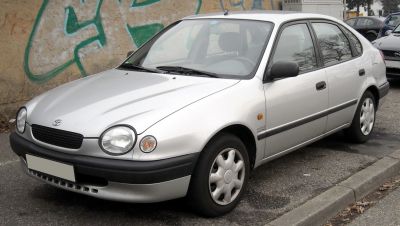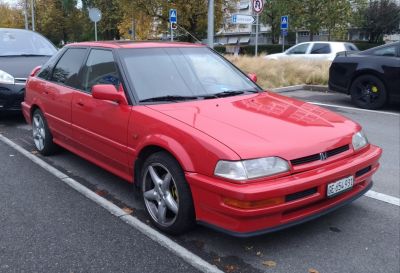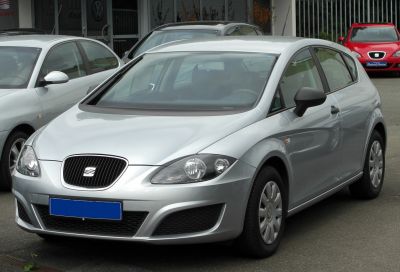 1998 Mazda 323 F VI (BJ) Dimensions, Size & Specs
1998 Mazda 323 F VI (BJ) Dimensions, Size & SpecsMeasurements of the 1998 Mazda 323 F VI, engineered for optimal performance and comfort
| Dimensions | |
|---|---|
| Length: | 4200-4290 mm165.4-168.9 in13.8-14.1 ft |
| Width: | 1705 mm67.1 in5.6 ft |
| Height: | 1410-1420 mm55.5-55.9 in4.6-4.7 ft |
| Trunk Capacity: | 355 liter12.5 cu ft |
| Trunk Capacity (Max): | 1000 liter35.3 cu ft |
| Weight Specifications | |
| Curb Weight: | 1070-1195 kg2359-2635 lbs |
| Maximal permitted Weight: | 1585-1715 kg3494-3781 lbs |
| Tire Specifications | |
| Rims Sizes: |
|
| Tire Sizes: |
|
The Mazda 323 F VI (BJ) is a compact hatchback produced between 1998 and 2003, representing the sixth generation of Mazda's 323 lineup. This model features a sleek design with a length ranging from 4200 to 4290 millimeters (approximately 165.4 to 168.9 inches), width fixed at 1705 millimeters (67.1 inches), and height spanning between 1410 and 1420 millimeters (55.5 to 55.9 inches). The vehicle's curb weight varies from 1070 to 1195 kilograms (2360 to 2635 pounds), offering a balance of lightweight agility and sturdy construction. Maximum weight ratings fall between 1585 and 1715 kilograms (3496 to 3781 pounds), indicating a reasonable payload capacity for passengers and cargo. The Mazda 323 F VI provides practical storage with a luggage capacity of 355 liters (12.5 cubic feet) under normal conditions, which expands significantly to 1000 liters (35.3 cubic feet) with the rear seats folded, making it versatile for everyday use and longer trips. It rides on rim sizes of 14 or 15 inches, supporting tire dimensions such as 175/65 R14, 185/65 R14, 195/55 R15, and 195/50 R15, enabling a range of wheel setups for different driving preferences and conditions. This generation of the Mazda 323 is well-regarded for its functional hatchback design, combining compact external dimensions with a surprisingly spacious interior and efficient use of cargo space.
Discover the standout features that make the 1998 Mazda 323 F VI a leader in its class
Have a question? Please check our knowledgebase first.
The Mazda 323 F VI (BJ), produced between 1998 and 2003, comes with a length ranging from 4200 mm to 4290 mm (approximately 165.4 to 168.9 inches). This variation depends on specific trim or model variations within the generation. This compact hatchback length positions it well within the subcompact car category, making it maneuverable and easy to park, especially in urban settings.
The Mazda 323 F VI (BJ) has a width of 1705 mm (67.1 inches). This relatively narrow width contributes to easier navigation through narrow city streets and tight parking spots. Internally, this width allows adequate shoulder room for passengers, consistent with many subcompact hatchbacks, balancing practicality and comfort for daily driving needs.
This Mazda generation has a height ranging between 1410 mm and 1420 mm (approximately 55.5 to 55.9 inches). This moderate height provides decent headroom for front and rear passengers, ensuring comfort without compromising the car's sleek, aerodynamic profile. The relatively low height also aids in reducing aerodynamic drag, which can improve fuel efficiency.
The curb weight of the Mazda 323 F VI (BJ) ranges between 1070 kg and 1195 kg (about 2,359 to 2,634 pounds). This lightweight construction benefits fuel economy, as lower mass requires less energy to move, and enhances handling agility. The car's balance of weight also contributes to stable driving dynamics, making it responsive and easy to control.
The maximum weight capacity of the Mazda 323 F VI (BJ) varies between 1585 kg and 1715 kg (roughly 3,496 to 3,779 pounds). This maximum weight includes the vehicle's curb weight plus passengers and cargo. Drivers should consider this limit to maintain safety and performance, ensuring they do not overload the car, which could impact braking, handling, and suspension.
The Mazda 323 F VI (BJ) provides a practical luggage capacity of 355 liters (12.5 cubic feet) with the rear seats upright. When the rear seats are folded down, the capacity significantly increases to 1000 liters (35.3 cubic feet). This versatility allows owners to transport larger items and increases the car’s usability for shopping, trips, and daily activities.
This generation of the Mazda 323 comes with rim sizes of 14 and 15 inches, paired with tire sizes including 175/65 R14, 185/65 R14, 195/55 R15, and 195/50 R15. Larger rims and lower-profile tires typically enhance handling and provide a sportier feel, while smaller rims with higher-profile tires offer a more comfortable and cushioned ride, allowing drivers to balance between responsiveness and road comfort.
Yes, the Mazda 323 F VI (BJ) fits comfortably into a standard garage. The typical garage size is usually about 2400 mm (94.5 inches) wide and 4800 mm (189 inches) long. Given the car’s length (4200-4290 mm) and width (1705 mm), it allows ample clearance for opening doors and maneuvering inside most standard residential garages, making it a practical choice for daily urban use.
Compared to its predecessor, the Mazda 323 F V generation, the 323 F VI (BJ) saw slight increases in length and curb weight. While exact dimensions vary by earlier model year, the newer generation grew to approximately 4200-4290 mm in length and weighs slightly more (1070-1195 kg). These dimensional changes improved interior space and safety without compromising maneuverability, offering a more modern and comfortable driving experience.
When compared to similar subcompact hatchbacks from the late 1990s and early 2000s, such as the Honda Civic hatchback or Volkswagen Golf Mk4, the Mazda 323 F VI (BJ) offers competitive dimensions and practicality. It is slightly shorter but comparably wide, with a well-designed interior space maximizing luggage capacity up to 1000 liters with seats folded. Weighing between 1070 and 1195 kg, it strikes a good balance between light weight and structural integrity, providing agility and efficiency on the road.
Discover similar sized cars.

| Production: | 1997-2001 |
|---|---|
| Model Year: | 1998 |
| Length: | 4270 mm168.1 in |
| Width: | 1690 mm66.5 in |
| Height: | 1385 mm54.5 in |

| Model Year: | 2013 |
|---|---|
| Length: | 4275 mm168.3 in |
| Width: | 1760 mm69.3 in |
| Height: | 1460 mm57.5 in |

| Production: | 2011-2014 |
|---|---|
| Model Year: | 2011 |
| Length: | 4320 mm170.1 in |
| Width: | 1765 mm69.5 in |
| Height: | 1440 mm56.7 in |

| Production: | 1993-2007 |
|---|---|
| Model Year: | 1993 |
| Length: | 4270 mm168.1 in |
| Width: | 1680-1690 mm66.1-66.5 in |
| Height: | 1385 mm54.5 in |

| Production: | 2004-2007 |
|---|---|
| Model Year: | 2004 |
| Length: | 4295 mm169.1 in |
| Width: | 1725 mm67.9 in |
| Height: | 1445 mm56.9 in |

| Production: | 2012-2014 |
|---|---|
| Model Year: | 2012 |
| Length: | 4300 mm169.3 in |
| Width: | 2065 mm81.3 in |
| Height: | 1440 mm56.7 in |

| Production: | 1989-1995 |
|---|---|
| Model Year: | 1989 |
| Length: | 4265 mm167.9 in |
| Width: | 1690 mm66.5 in |
| Height: | 1395 mm54.9 in |

| Production: | 2009-2010 |
|---|---|
| Model Year: | 2009 |
| Length: | 4315-4323 mm169.9-170.2 in |
| Width: | 1768 mm69.6 in |
| Height: | 1459 mm57.4 in |
